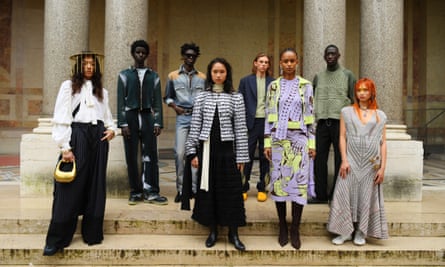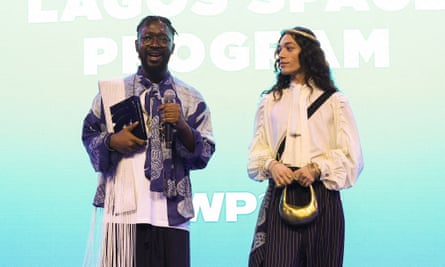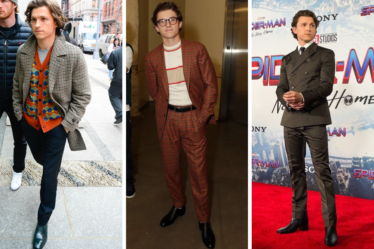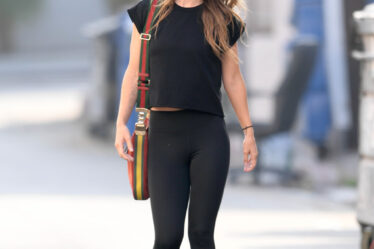
As a new designer, how do you attract the fashion world’s attention? Create a piece made for stunt dressing? Persuade an “it girl” such as Hailey Bieber to wear it?
Breaking into £2tn global fashion industry has never been easy, but recently things have become even tougher.
Many fashion graduates leave university burdened with debt (the fees for studying for a BA in fashion design at London’s Central Saint Martins cost more than £9k per annum for UK students). Internships – the standard way of gaining experience in the industry – are regularly unpaid or pay minimum wage, while the majority of jobs are based in the capital where average rent prices recently hit a record high of £2,210 per property per month.
Following the global pandemic, the ongoing economic crisis and Brexit, the British Fashion Council called on the government for support, highlighting that much of the above-average growth made by the UK in the past 10 years could easily be wiped out.
Even some established designers work from one collection to the next, relying on sponsorship from even bigger brands. Last year, Matty Bovan received financial backing from Dolce & Gabbana, while Richard Quinn was supported by the credit score company Clearpay. Sometimes this isn’t enough, though, and hotly tipped designers such as Sibling are forced into voluntarily liquidation.
However, there is another path that many designers take in the hope of catapulting themselves to success: entering a competition.
Two elements make contests attractive. Firstly, they offer the chance for designers to gain some serious capital to get their brand off the (bedroom) floor. And, secondly, contests can help get their names out into the industry, giving them the opportunity to widen their network.
One of the most established awards for rising stars in the industry is the International Woolmark prize. The competition was founded in Paris more than 80 years ago, where it was won by a then-unknown designer called Valentino Garavani, founder of his namesake brand Valentino. In subsequent years, Yves Saint Laurent and Karl Lagerfeld have scooped first place.
“So much of what is inaccessible for young designers is just being in the room,” says Sinéad Burke, a disability activist, Vogue cover star and judge on the Woolmark panel. “This process gives access to those key industry professionals and the finalists are able to build relationships with them.”
Surprisingly for an industry that prides itself on exclusivity, open contests that level the playing field have been widely welcomed by its gatekeepers. In addition to the Woolmark prize, in France there’s also the Andam prize (Martin Margiela is a previous winner) and the LVMH prize (Jacquemus won it in 2015).
In the UK, there’s the Queen Elizabeth II Award for British Design that first launched in 2018.
On Thursday, King Charles presented the award to Foday Dumbuya, founder and creative director of Labrum London. The king remarked on the vital support that the British Fashion Council provides to new designers; in the last financial year it delivered over £1.2m in funds to designers and scholars.
One of its funds, the BFC/Vogue Designer Fashion Fund was won most recently by the cult womenswear label 16Arlington. “Prizes are vital for independent businesses like ours”, says 16Arlington’s Marco Capaldo, who received a £150,000 cash prize. “They offer us the chance to expand our business and look to future growth as well as providing the most incredible platform for the brand.”
On Tuesday, six months after being whittled down from more than 100 to just eight finalists, the winners of the 2023 Woolmark prize were revealed at a ceremony at the Petit Palais.
Lagos Space Programme, a Nigerian-based brand founded by Adeju Thompson that aims to shift common perceptions of African fashion won, while another prize – the Karl Lagerfeld award for innovation – went to the Danish brand A Roege Hove, whose form-fitting and cut-out pieces subvert traditional knitwear designs.
“I’m just happy. I’m speechless,” said Thompson (who uses they/them pronouns), as they posed for the press with their trophy. They received $200,000 Australian dollars (just over £100k in British pounds) while Denmark’s Amalie Røge was awarded AU $100,000 (around £53,000).
Thompson said the award was particularly meaningful to them, because there isn’t any kind of sponsorship for designers in Nigeria. “You truly are independent,” they said, adding that their team of six also worked without a consistent supply of electricity. “Due to rampant government corruption and [other factors], a lot of people that would have been considered national treasures have been forgotten. Lagos Space Programme does elevate voices and supports people financially, and this is also a win for them,” they said.
after newsletter promotion

With a government fuel subsidy being lifted next month, Thompson plans to use some of the prize fund to invest in a solar panel rather than relying on the national grid.
Last November, each Woolmark prize finalist was given AU $60,000 (£32,000) and tasked with creating six pieces using merino wool. To help them achieve this, they were also given access to a panel of fashion experts spanning everything from supply chain to the commercial buying process and e-commerce styling. Unlike other competitions where a standalone collection is required, the Woolmark prize lets entrants use the pieces as part of their regular seasonal showcase.
“It means it doesn’t cost us anything to enter,” says finalist Robyn Lynch. “I showed some of my entry pieces as part of my autumn/winter 2023 collection in February.”
“The idea is that, as a finalist, you have education resources, a supplier network and a financial structure to help you build the collection you are going to enter,” Burke explains. “It makes the assessment more equitable because some brands competing are bigger than others.”
The eight finalist collections were then judged by a panel that included Alaïa’s creative director, Pieter Mulier; Alessandro Sartori, artistic director of Zegna; Francesco Risso, creative director of Marni; and the photographer Tyler Mitchell.
“This is a moment that will change the designer’s life,” says Sartori. “It’s not just about the money, it’s all the media exposure that comes with it, and the industry support is a game changer.”
“The mentorship is priceless,” says Røge who, through the scheme, began working with a new factory and a yarn mill, and discovered a new stockist in China. Røge plans on spending her prize fund on a digital printing machine.
For those who didn’t win, getting access to Woolmark’s global supply chain to create their entries still helped to propel their brands forward. “Factories tend to have a minimum sample fabric order of 500 to 1,000 metres,” explains Lynch. “We would typically need just 10 metres, so we wouldn’t normally even get a reply.” With restrictions lifted, Lynch was able to access a wide range of technical fabrics that further pushed her creativity. She hopes to continue using these suppliers.
For Thompson, who references designers including Yohji Yamamoto and Rei Kawakubo and worked with suppliers in Japan, the prize couldn’t have come at a better time. Gearing up to make their Paris fashion week debut in June, they say it allows them to focus on “a proper debut” while also attracting more viewers.
“Fashion is tough,” says Thompson, who founded Lagos Space Programme in 2014. “When you are first finding your voice, there is so much self doubt. It’s tempting to just go and work for a brand. However, I’ve really worked on fine-tuning my message. As a queer person from Nigeria, it’s very important to communicate who I am. Winning this feels like it’s come at the right time.”
If you want to read the complete version of this newsletter please subscribe to receive Fashion Statement in your inbox every Thursday.



